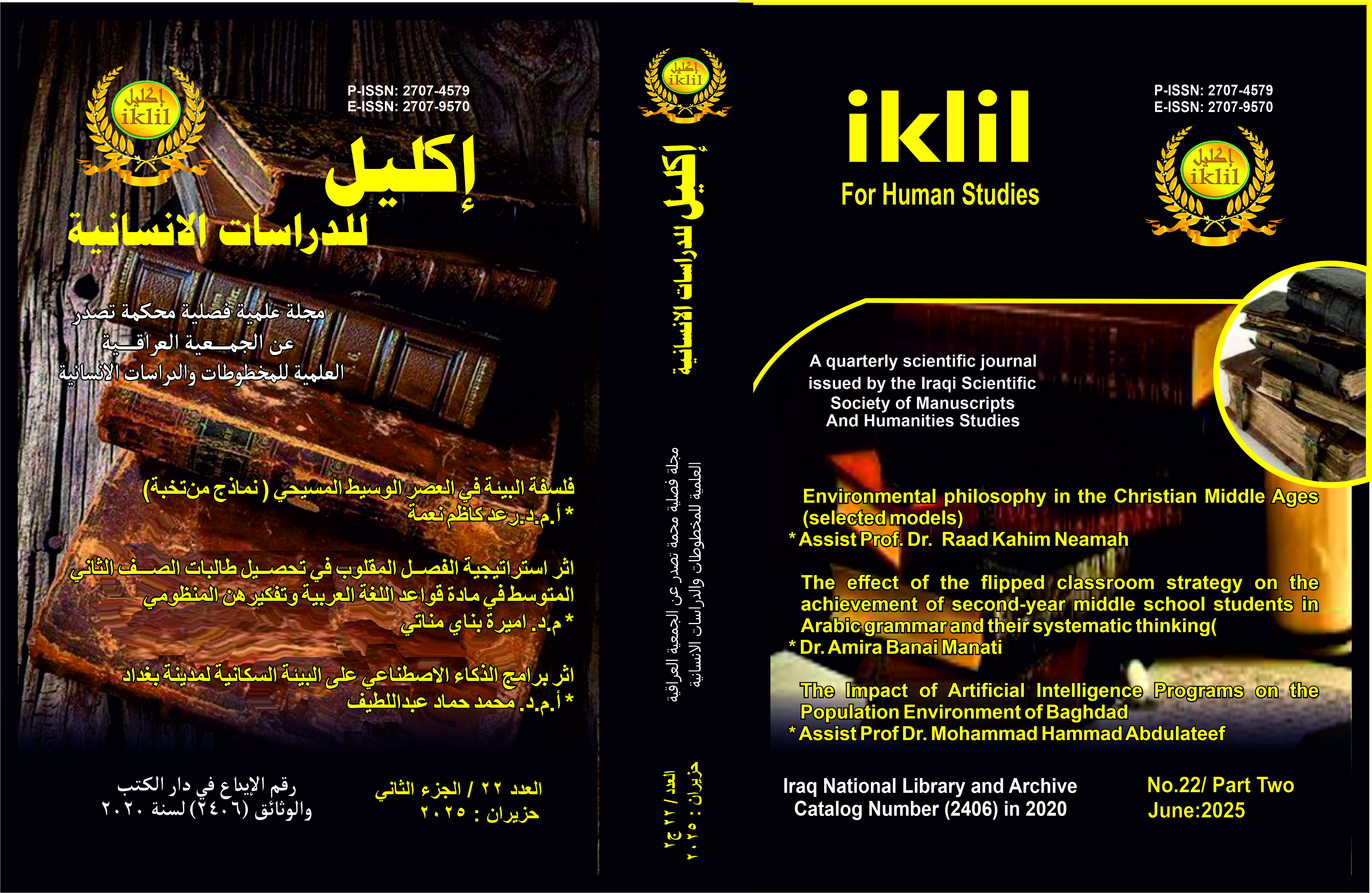Abstract
The Qur'anic discourse is considered a unique model in employing rhetorical techniques to serve doctrinal and educational purposes. Among these techniques, the alerting function (tanbīh) emerges as one of the key tools in awakening the awareness of the recipient and involving them in the structure of the discourse. In this context, Surah Hud stands out as a rich example filled with alerting cues that are employed in service of the thematic structure of the Surah—especially in conveying the message of faith, affirming divine laws, and encouraging reflection on the destinies of past nations.
This study aims to explore the presence of the alerting function in Surah Hud, analyze its tools and stylistic manifestations, and clarify its semantic impact in shaping the discourse. The researcher adopted a descriptive-analytical approach, drawing upon modern stylistic and rhetorical studies, while being guided by the rich Arabic linguistic and rhetorical tradition. Among the most prominent alerting tools identified in the Surah are:
The explicit alerting particle "Ala" ألا, which occurs to provoke mental alertness and prepare the audience for a significant meaning or critical conclusion. The vocative particle "Ya" يا, especially when directed at the Prophet or specific groups of people, which adds further intensity and focus to the message.
Demonstrative pronouns such as this, these, those (which draw attention and emphasize the subject being referred to. The findings show that the alerting function in the Surah is not marginal or incidental; rather, it is integrated with other core functions such as informative, argumentative, and persuasive elements. It contributes significantly to capturing the listener’s attention to the major truths conveyed by the Surah—such as monotheism, resurrection, divine reward and punishment, and the laws of destruction and victory. The role of alerting is also evident in the transitions between sections and in highlighting the moral lessons drawn from the stories of the prophets and their peoples.
This study aims to explore the presence of the alerting function in Surah Hud, analyze its tools and stylistic manifestations, and clarify its semantic impact in shaping the discourse. The researcher adopted a descriptive-analytical approach, drawing upon modern stylistic and rhetorical studies, while being guided by the rich Arabic linguistic and rhetorical tradition. Among the most prominent alerting tools identified in the Surah are:
The explicit alerting particle "Ala" ألا, which occurs to provoke mental alertness and prepare the audience for a significant meaning or critical conclusion. The vocative particle "Ya" يا, especially when directed at the Prophet or specific groups of people, which adds further intensity and focus to the message.
Demonstrative pronouns such as this, these, those (which draw attention and emphasize the subject being referred to. The findings show that the alerting function in the Surah is not marginal or incidental; rather, it is integrated with other core functions such as informative, argumentative, and persuasive elements. It contributes significantly to capturing the listener’s attention to the major truths conveyed by the Surah—such as monotheism, resurrection, divine reward and punishment, and the laws of destruction and victory. The role of alerting is also evident in the transitions between sections and in highlighting the moral lessons drawn from the stories of the prophets and their peoples.
Keywords
Function - Alert - Hood - The Holy Quran
Abstract
يعدّ الخطابُ القرآنيُّ نموذجًا فريدًا في توظيفِ الأساليبِ البلاغيّةِ و الدلالية لخدمةِ المقاصدِ العقديّةِ والتربويّةِ، ومن بينِ هذه الأساليبِ تبرزُ الوظيفةُ التنبيهيّةُ كأحدِ المفاتيحِ المهمّةِ في استنهاضِ وعيِ المتلقّي وإشراكِه في بنيةِ الخطابِ، وفي هذا السياقِ جاءتْ سورةُ هودٍ نموذجًا غنيًّا بالدلالاتِ التنبيهيّةِ التي تُوظَّفُ لخدمةِ البناءِ الموضوعيِّ للسورةِ، لا سيّما في سياقِ توجيهِ الرسالةِ الإيمانيّةِ، وتقريرِ السُّننِ الإلهيّةِ، وتحفيزِ التأمّلِ في مصائرِ الأممِ.
تهدفُ هذه الدراسةِ إلى استكشافِ حضورِ الوظيفةِ التنبيهيّةِ في سورةِ هودٍ، وتحليلِ أدواتِها وتجلياتِها الأسلوبيّةِ، وبيانِ أثرِها الدلاليِّ في توجيهِ الخطابِ. وقد اعتمدَ الباحثُ على المنهجِ الوصفيِّ التحليليِّ، مستندًا إلى الدراساتِ الأسلوبيّةِ والبلاغيّةِ الحديثةِ، ومسترشدًا بالتراثِ اللغويِّ والبيانيِّ العربيِّ.
ومن أبرزِ أدواتِ التنبيهِ التي تمّ رصدُها في السورةِ:
أداةُ التنبيهِ الصريحةِ (ألا) التي تَردُ لتُحدثَ يقظةً ذهنيّةً وتُمهّدَ لمعنى خطيرٍ أو استنتاجٍ جوهريٍّ، والنداءُ بـ(يا)، خاصّةً عندما يُوجَّهُ إلى النبيِّ أو إلى فئاتٍ معيّنةٍ من الناسِ، ممّا يشحنُ الخطابَ بمزيدٍ من التركيزِ والانتباهِ، والتنبيهُ بأسماءِ الإشارةِ (هذا، هذه، هؤلاء، أولئك, التي تُضفي على القولِ تنبيهًا وتأكيدًا للشيءِ المشارِ إليه.
وتُظهرُ النتائجُ أنَّ الوظيفةَ التنبيهيّةَ في السورةِ لم تكنْ وظيفةً عارضةً أو هامشيّةً، بل جاءتْ متكاملةً مع الوظائفِ الإخباريّةِ والحِجاجيّةِ والإقناعيّةِ. وقد أسهمتْ في شدِّ انتباهِ المتلقّي إلى الحقائقِ الكبرى التي تعرضُها السورةُ، كالتوحيدِ، والبعثِ، والجزاءِ، وسُننِ الاستئصالِ والنصرِ، كما تجلّى دورُ التنبيهِ في الانتقالِ بين المقاطعِ، وفي إبرازِ العِبَرِ المستخلصةِ من قصصِ الأنبياءِ مع أقوامِهم.
تهدفُ هذه الدراسةِ إلى استكشافِ حضورِ الوظيفةِ التنبيهيّةِ في سورةِ هودٍ، وتحليلِ أدواتِها وتجلياتِها الأسلوبيّةِ، وبيانِ أثرِها الدلاليِّ في توجيهِ الخطابِ. وقد اعتمدَ الباحثُ على المنهجِ الوصفيِّ التحليليِّ، مستندًا إلى الدراساتِ الأسلوبيّةِ والبلاغيّةِ الحديثةِ، ومسترشدًا بالتراثِ اللغويِّ والبيانيِّ العربيِّ.
ومن أبرزِ أدواتِ التنبيهِ التي تمّ رصدُها في السورةِ:
أداةُ التنبيهِ الصريحةِ (ألا) التي تَردُ لتُحدثَ يقظةً ذهنيّةً وتُمهّدَ لمعنى خطيرٍ أو استنتاجٍ جوهريٍّ، والنداءُ بـ(يا)، خاصّةً عندما يُوجَّهُ إلى النبيِّ أو إلى فئاتٍ معيّنةٍ من الناسِ، ممّا يشحنُ الخطابَ بمزيدٍ من التركيزِ والانتباهِ، والتنبيهُ بأسماءِ الإشارةِ (هذا، هذه، هؤلاء، أولئك, التي تُضفي على القولِ تنبيهًا وتأكيدًا للشيءِ المشارِ إليه.
وتُظهرُ النتائجُ أنَّ الوظيفةَ التنبيهيّةَ في السورةِ لم تكنْ وظيفةً عارضةً أو هامشيّةً، بل جاءتْ متكاملةً مع الوظائفِ الإخباريّةِ والحِجاجيّةِ والإقناعيّةِ. وقد أسهمتْ في شدِّ انتباهِ المتلقّي إلى الحقائقِ الكبرى التي تعرضُها السورةُ، كالتوحيدِ، والبعثِ، والجزاءِ، وسُننِ الاستئصالِ والنصرِ، كما تجلّى دورُ التنبيهِ في الانتقالِ بين المقاطعِ، وفي إبرازِ العِبَرِ المستخلصةِ من قصصِ الأنبياءِ مع أقوامِهم.
Keywords
الوظيفة . التبهية . هود . القرآن الكريم
